Mandragora, MandrakeYabruj (Unani)Feng Jia 风茄 |

|

|
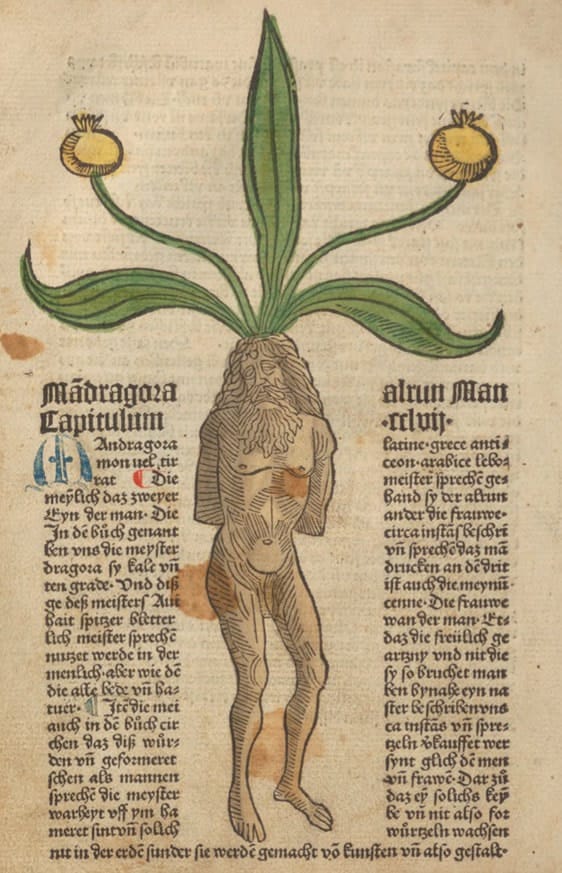 Gart der Gesundheit, Cuba, 1485
Gart der Gesundheit, Cuba, 1485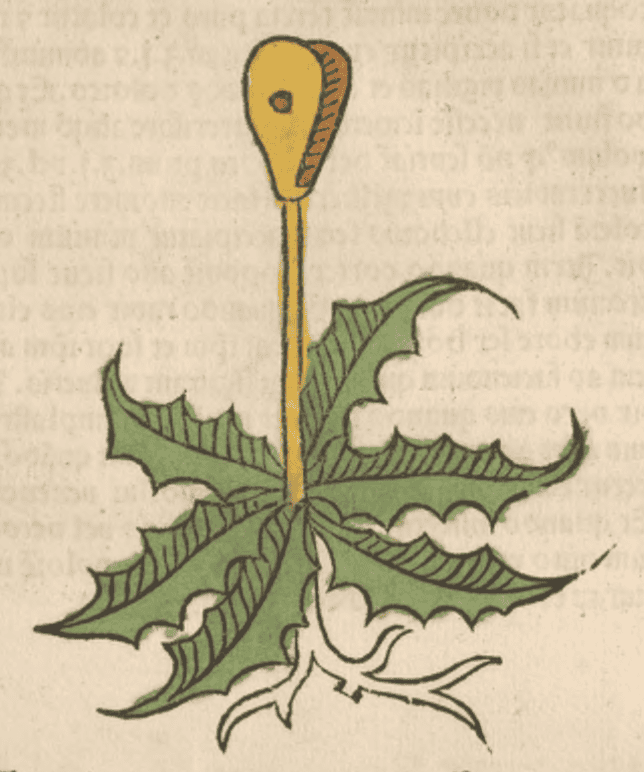 Herbarius latinus, Petri, 1485
Herbarius latinus, Petri, 1485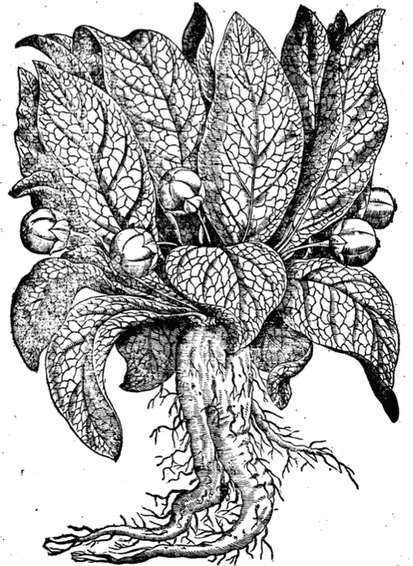 New Kreuterbuch, Matthiolus, 1563
New Kreuterbuch, Matthiolus, 1563
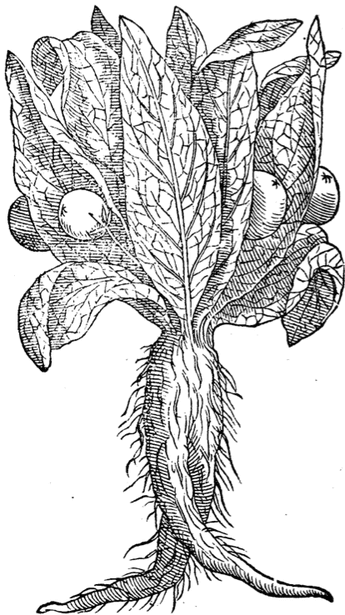
|
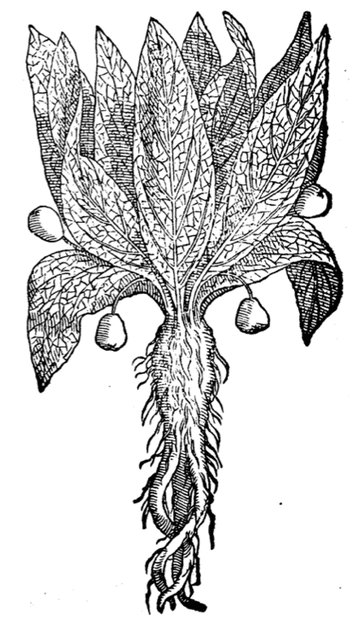
|
Della Materia Medicinale, Andrea Valuassori, 1562
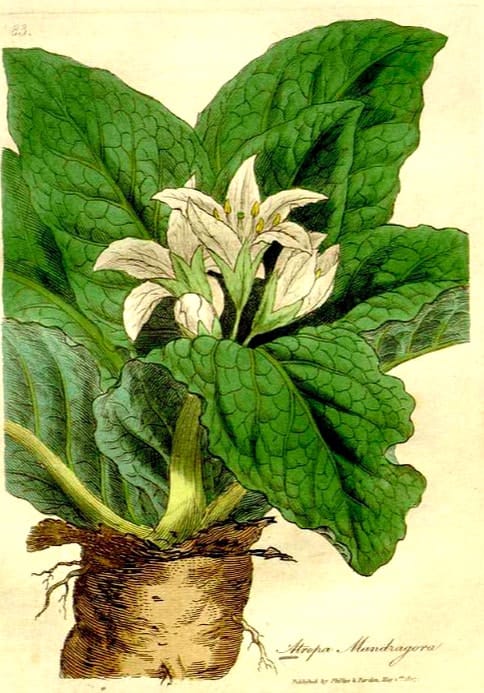 W. Woodville, W.J. Hooker, G. Spratt, Medical Botany, 3th edition, vol. 2: t. 83 (1832)
W. Woodville, W.J. Hooker, G. Spratt, Medical Botany, 3th edition, vol. 2: t. 83 (1832)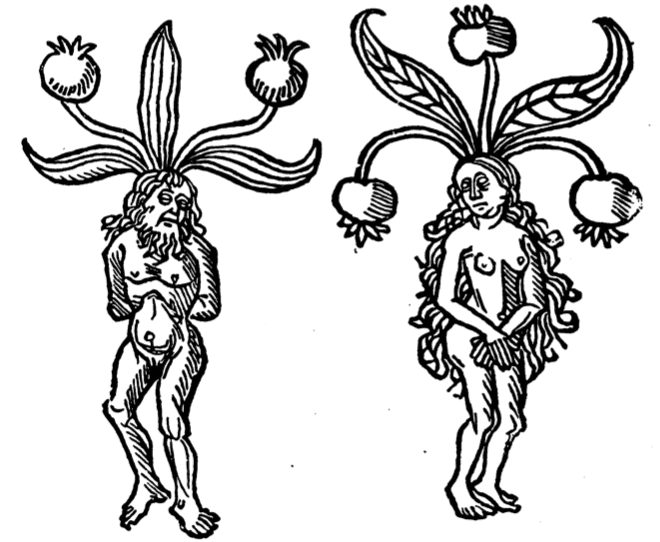
Male and Female Mandrakes
(Hortus Sanitatis, 1486)
|
Male & Female Mandrake, Ortus Sanitatis, Meydenbach, 1491 |
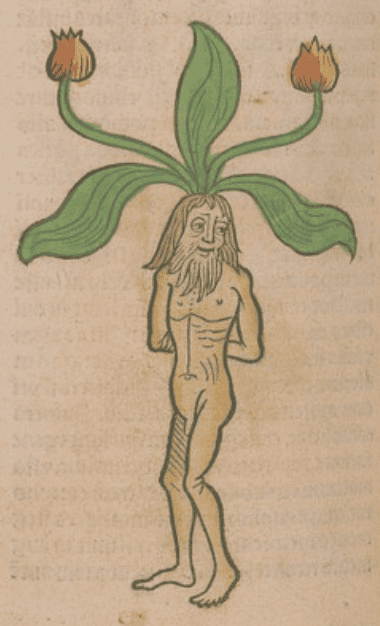
|
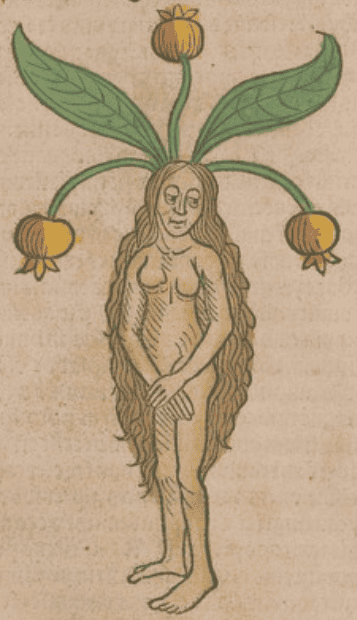
|
Botanical name:Mandragora officinalis Parts used:Root-bark; less commonly ‘apples’ (fruit) or leaf Temperature & Taste:Very Cold, dry. Bitter. Toxic.. Avicenna said it is Cold and moist. Classifications:2F. PURIFYING. 2L. EMOLLIENT. 2R. NARCOTICS & HYPNOTICS |
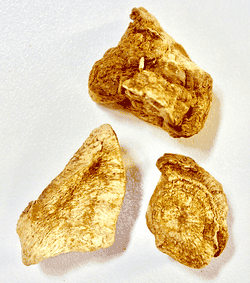
|
Left: pieces of dried Mandrake root. |
Uses:
1. Calms the Mind, Promotes Rest, Stops Pain:
-A ‘wonderful Narcotic and Soporific’ (Schroder);
-strong pain; promotes rest
-anesthetic for minor surgery
-Melancholy, Mania, Depression
-used as a sedative by Hippocrates
2. Moves the Blood, Promotes Fertility:
-promotes Menstruation and clears a Dead Fetus
-long used for female Infertility (Theophrastus mentioned it in the 4th century BC; also in the Bible)
3. Externally:
-An infused oil is good for hot pain and inflammation, red and sores eyes, Strumas, hard Tumors and Epilepsy (applied to the spine)
-topically for sore, red Eyes (bark)
-Erysipelas, red and inflamed skin conditions
-applied to Hard Tumors and Strumas
-Arthritic disorders including Arthritis deformans
-fresh leaves were applied to Wounds
Dose:
‘Seldom used internally’, although preparations of it were used as an anesthetic.
ROOT POWDER: 30–90mg, up to 120 or 150mg;
ROOT TINCTURE (1:10 in 70% alcohol): 5–10, or 15 drops, 2-3 times daily; or 5 drops of the Tincture in 100mls. water, take a teaspoonful hourly.
For cautery and surgery, 1–1.5 drams of the root juice was taken with Hydromel “but if taken too much it kills”. (Herbarius latinus, Petri, 1485)
Most commonly used externally in Oils, Tinctures and Inhalations for pain, and to promote sleep or anesthesia for surgery, cauterisation and amputation.
Comment:
English Mandrake sometimes refers to Bryony and American Mandrake is Podophyllum.
Correctives:
Ivy berries correct the effect of Mandrake fruit on the brain and senses, according to Tacuinum Sanitatus
Substitutes:
1. Black Hellebore leaves were used in place of Mandrake leaf in Ungentum Populeum by French Apothecaries. (Pomet)
Main Combinations:
PAIN / SPASM
1. Analgesic
i. Mandrake root-bark with Henbane, Calamint, Rue, Cumin, Bay berry, Opium (as in Philonium Hamech)
ii. Mandrake with Poppy seed, Henbane seed, Winter Cherry, flowers of Violet and Camomile (as in Pain Easing Tincture); this was applied to the temples, forehead and pulses, but was also used internally.
2. Ease Pain, promote Sleep:
i. Celsus recommended put Mandrake fruit under the pillow to promote sleep.
ii. Mandrake root-bark with Poppy seed, Henbane seed, Saffron
iii. Mandrake root-bark with Violet, Water Lily flower, Dill seed, Rose, Opium (as in Pugillus Somnifer)
iv. Mandrake root-bark with Poppy root, Henbane seed, Poppy seed, Winter Cherry, Camomile, Violet (as in Tinctura Somnum Producens)
v. Mandrake juice with Henbane seed, Black Nightshade juice, Water Lily juice, Lettuce juice, Camphor (as in Somniferos Sponge)
vi. Mandrake root-bark with Henbane seed, Olibanum, Myrrh, Gentian, Saffron, Opium with clarified Honey (as in Musa Aenea of Nicholas)
3. Severe Intestinal Pain:
i. Mandrake root-bark, Henbane seed, Saffron, Myrrh, Frankincense, Opium, Castoreum, powder, make a paste with wine and form into tablets. (Syrian ‘Book of Medicine‘, Budge, 1913)
ii. Mandrake root-bark, Parsley seed, Ammi, White Pepper, Saffron, Opium, made into an Electuary with Honey. (Syrian ‘Book of Medicine‘, Budge, 1913)
4. Headache, Insomnia, Mandrake root-bark with Myrrh, Opium, Henbane seed, Saffron (as in Triangular Troches, for topical use)
BLADDER PAIN / ULCER
5. Bladder pain from Ulcers, Mandrake root-bark with Licorice juice, Myrrh, Frankincense, Mastic, Tragacanth, Poppy seed (as in Electuarium ad Dolorem Vesica cum Ulcer)
6. Heat and Ulcer of the Bladder, Mandrake root-bark with Dragons Blood, Henbane seed, Melon seed, Cucumber seed, Pumpkin seed, Poppy seed, Celery seed, Licorice juice
LIVER
7. Liver Ulcer, Mandrake root-bark with Licorice, Comfrey, Senna, Asarum, Rhubarb, Poppy seed, Aniseed (as in Troches for Liver Ulcers of Andromachus)
HEART
8. Heart pain, Palpitations, Shortness of Breath, Zerumbet, Doronicum, Euphorbium, Coral, Pearl, Pyrethrum, Clove, Mandrake seed, Saffron, Camphor (Syrian ‘Book of Medicine‘, Budge, 1913)
COUGHING
9. Coughing up Blood or Pus, Henbane seed, Mandrake bark, Frankincense, Opium, Storax Cypress nut, Amber (Syrian ‘Book of Medicine‘, Budge, 1913)
10. Phthisis and Coughing up Pus, Mandrake root-bark, Parsley seed, Myrrh, Saffron, Aniseed, Parsnip, White Pepper, Castoreum Sagapen, Opopanax (equal parts). Powder and mix with Honey to an Electuary. Dose:as much as a Chestnut. (Syrian “Book of Medicine“, trans. by Wallis Budge, 1913)
REPRODUCTIVE:
11. Aphrodisiac, the scraped root is saoked in vinegar and taken internally. (Theophrastus)
12. Cold and Moist Uterus, Mandrake root-bark with Cyperus, Hyssop, Mugwort, Agnus Castus, Peony seed, Cassia Wood
13. Uterine Bleeding, Menorrhagia:
i. from Heat, apply Mandrake oil over the Uterus
ii. Mandrake seed, Sulphur (Avicenna)
14. Infertility:
i. from Heat, Water of Mandrake (1 oz), Water of Water Lilies (4 oz.), Saffron (half scruple) (Wirtzung)
ii. Mandrake root-bark with Peony seed, Musk (to be applied on cotton and inserted into the Vagina)
iii. Mandrake root-bark with Peony seed, Agnus Castus, Rose, Long Pepper, Cassia Wood with Tryphera Magna
EXTERNALLY:
15. Abscess, the oil can be applied, the fresh leaf can be beaten and applied, or the leaf powder mixed with a suitable juice and applied.
16. Severe Eye pain: Saffron, Myrrh, Frankincense, Opium, Gum Arabic (equal parts). Form pills; to use dissolve in Tincture of Henbane or Mandrake and paint over the eyelids and temples. (Syrian ‘Book of Medicine‘, Budge, 1913)
Major Formulas
Potion to Procure Sleep
Confection to Promote Sleep
Powder to Promote Pregnancy (Renodeus)
Powder for Madness (2) (Rondeletius)
Confection for a Cold and Moist Uterus
Triangular Troches (Unani)
Requies (Nicholas)
Triphera Greater (Nicholas)
Troches for Liver Ulcers (Andromachus)
Antidotum Asclepiadus Minus (Nicholas)
PAIN EASING TINCTURE.
Mandrake bark 1½ drachm
Poppy root
Black Poppy seed,
Henbane seed 2 drachms ea.
Winter Cherries 4 drachms
Opium 1 Scruple
Flowers of Violet and
Camomile ½ handful ea.
Make a tincture with S.V. by digestion in B.M. Eases pain, causes rest and sleep. Anoint on the temples and forehead, and also the pained place. (Salmon)
MANDRAKE OIL. (Nicholas)
Juice of Mandrake Apples,
or of the Leaves 4 oz.
Juice of White Henbane 2 oz.
Juice of Black Poppy Heads 3 oz.
Juices of Violets
of Hemlock 1 oz. ea.
Opium,
Storax Calamita ½ oz. ea.
Common (Olive) Oil 2 lbs.
Set them all in the Sun for 10 days, then boil to the consumption of the juices, and strain; then add the Opium finely beaten, and the Storax which has been dissolved in 0.5 oz. of Turpentine, and mix them according to art.
Invented to ease violent pains of the Head. Also used for ‘Frenzies, Madness, Unquietness and much watching’. For these, the Forehead, Temples, Nostrils, Pulses, and soles of the Feet are anointed; also very good for Gout pain, running Gout, and inveterate Joint pains. Applied to to promote rest and sleep.
3. “SLEEPING APPLE”
Opium
Mandrake
Hemlock juice
Henbane seed equal parts
Musk a little
Form into a large bolus. It is held in the hand and smelled to induce sleep. (Natural Magick, Porta, Giambattista della, 1669)
Cautions:
1. Toxic in overdose. Generally only used externally.
2. Not used during Pregnancy
3. ‘… for through the great coldness which Opium, and Hyoscyamus, and Mandragora root possess, they kill the natural heat of the ordinary member of the body, and bring the sick man into great and inconceivable peril’. (Syrian ‘Book of Medicine‘, Budge, 1913)
Antidotes:
1. Radish root eaten with bread and Salt for 3 days (De venenis, Petrus, 1487)
2. Wormwood, Rue, Scordium, Mustard, Oregano, with wine and vinegar (Pomet)
3. Pulegium, Oregano, Wormwood, Rue, Scordium in decoction, or powder with wine or vinegar.
4. Wormwood wine can be taken
5. Theriac
6. Bezoar
Main Preparations used:
Oil prepared of the Bark decocted in Oil was used for strong pain
-
Extra Info
-
History
|
In the Nighantas the root of this plant bears the names of Lakshamana, “possessed of lucky signs or marks”; Putra-da, “child giver”; Rakta-vindu, “a drop of blood”; and Bhagini, “co-heiress.” It is described as a promoter of conception, aphrodisiac, and a corrective of the condition known as tri-dosha, or a disorder of the three humors of the body: bile, blood and phlegm. The Hindus appear to have derived their knowledge of the drug from Western nations, or possibly from the Chinese, as the only Indian species of Mandragora, M. caulescent, Clarke, is not known to be used medicinally. From the time of Hippocrates to the first century of the Roman Empire, mandragora was used medicinally by the Greek physicians, sometimes as an anaesthetic before surgical operations, but more frequently as an application to painful tumours. The root bark was preferred as being tho most active part, but the leaves were also used, more especially for local application. Internally the juice of the root was usually administered in wine or vinegar. The description of the action of mandragora juice given by Dioscorides and Pliny leave no doubt of its resemblance to that of belladonna. Theophrastus and Dioscorides mention that the plant was also used in love philtres, which appears to be explained by the sensual excitement and hallucinations that are observed in datura poisoning. Like many other medicinal plants Mandrake appears always to have been collected with certain superstitious ceremonies; it was supposed that it could only be drawn from the ground without danger to the collector by the assistance of a dog, who, after the earth round the root had been removed, was tied to it by the neck and beaten until his struggles effected its extraction, and not unfrequently the death of the animal. The ancients speak of two kinds of Mandragora, male and female, the former has been identified as M. vernalis, Berth.; it has larger leaves and fruit than M. officinarum. From the time of Theophrastus up to the fifth century of our era the superstitions which have surrounded the mandrake appear to have gradually multiplied: we then find it spoken of as anthro-pomorphon and semi-homo, and described as having a human form and wonderful fertilizing powers. In the Middle Ages it became a mystical magic root, which existed only in fancy and was represented by a fictitious image in the form of a man or woman |
manufactured from some other root, and used by priests and charlatans as a charm. It is the Alruna of German mythology, which was believed to be a gallow’s manniken sprung from the seed of men who were hanged; that when pulled out of the earth by a black dog it shrieked like a child. It came to be regarded as a kind of talisman or fetish which could bring good fortune to its possessor. In France it was known as Mandaglorie or Maglore (main de gloire), and was regarded as a kind of fairy which if well treated would bring good luck to its owner. Dr. Pereira mentions his having seen a rude representation of a human figure fashioned out of the root of Bryonia dioica, exhibited at an herb shop in England as a Mandrake. The Arabs call the Mandrake Luffah, a name which they also apply to a kind of melon known in Syria as Shammam and in Persia as Dastambuyeh, “perfuming the hands”, the Eucumus Dudaim of Linneaus, and supposed to be the Dudaium or “love apple” of Gen. XXX 14. In Persia the mandrake is known as Mardumgyah and Sagshikan. Mahometan medical writers, under the name of Yebruj, Yebruh or Yebruj-el-sandam, reproduce with slight modifications the European myths concerning the plant. Haji Zein-el-Attar states that on the borders of the Garmasir of Shiraz, near the fort of Shahryari, mandrake root was in his time (A.D. 1368) collected with the assistance of dogs, and was known as Sagkand (Sag “a dog”, and kandan “to dig”). In cases of poisoning by it he recommends emetics and the administration of aromatics in milk, and concludes by saying that it is beyond the province of medicine to discuss its use in love-philtre. Mandrake roots, though not well-known in India, are occasionally offered for sale as a charm; the narcotic properties of the plant do not appear to be known to the natives. In China the plant is said to be much used as an anaesthetic, and in Europe the leaves are still sometimes used as a local application to tumors. Guibourt says “Les feuilles fort partie du bauma tranquilla (Elaeole de solanees compose). (Pharmacographia Indica, Dymock, 1891) |
How to Make Men Mad with Mandrake
We have told you, That a small dose brings sleep; a little more, madness; a larger, death. Dioscorides saith, That a Drachm of Morion will make one foolish; We will easilier do it with Wine, which is thus made: Take the Roots of Mandrake, and but put them into new Wine, boiling and bubbling up; cover it close; and let them infuse in a warm place for two months. When you would use it, give it to somebody to drink; and whosoever shall taste it after a deep sleep, will be distracted, and for a day shall rave: but after some sleep, will return to his senses again, without any harm: and it is very pleafant to behold. Pray make trial. (Natural Magick, Porta, Giambattista della, 1669)
Concerning the kahina root [Mandrake], and the answer of Dioscurus about the wonderful things which it doeth among men.
|
The [name of] this Kahina (i.e., splendid) root, being interpreted is “expeller of devils” and it is called ” foetid of smell”. Know thou that this root was the firstborn of all the roots which came up from the earth, and King Solomon was wont to use it. It cometh up from the earth one cubit, and its blossoms are red like [those of] a rose, and its branches and leaves are like [those of] beans. And after the flower of this root, which resembleth that of a rose, hath died away, there remain on the top thereof two little balls which are like the testicles of a man, and inside them there are black and red seeds. When thou wishest to pull up this root, cleanse thyself from impurity, and eat not bread which hath been made by women. And wash thy head, and array thyself in white apparel, and keep fasting until thou seest the stars. And come thou to this root on the sixth day of the month lyyar, and say thou to it “Peace be to thee, O Kahina root” It will bring an answer concerning everything that the earth maketh to grow. The prayer for the root. “Unto Thee, O Lord, Lord God, the Mighty One, I cry, Who art the Eternal, and the ever-living One, and the Begetter of life in all parts [of the earth], Who hearest and understandest; Creator of all the worlds, the Exalted One among all things which exist, of the Sun and Moon, and of the stars, and of the earth, and of the sea, and of the dry land, the Creator of all creations, the Beautiful Name, and the Giver of understanding, O give Thou unto us this good root for the healing of all the children of men”. And every evening when thou goest to it thou shalt say unto it, “Be thou well, O splendid root, with beneficent health!” And when thou hast finished this prayer say “Peace be unto thee, O root, for thou reignest over all roots”. Thus shalt thou do three days. And on the fourth day come in the morning before sunrise, and dig up the ground on all four sides of it, to the depth of a cubit on each side. Then bring a black dog, and tie one end of a rope round his neck, and tie the other end of the rope to that root, and then smite the dog until he pulleth this root up out of the ground. And when thou hast pulled it up, bring a thin plate of gold or silver, and tie it up in a piece of new, clean linen, and bury it in the place where the root was, and cover it over. And take the root, and go to [thy] house or the church, and place it in the hollow of the head of the door, or on the seat of God, and take fine incense from the church, and cense it before Him. And recite this prayer: “O God, Thou Sustainer of All, Who wiliest all things, Who preservest all things, Thou Name, beautiful and ornamented in all things, Thou Creator of the Sun and Moon, give Thou unto me, O my Lord, in Thy mercy, the actual and peaceful possession of this root, in all its operation, together with the power thereof, so that it may be for the healing, and cure, and relief of the souls of all the children of men. Let it come unto me with all its working powers. Yea and Amen.” |
Now thou shalt take good heed to this root, and to all the manifold power and great healing which are therein. If thou takest a part of it in thy hand, and dost go into judgement, thou shalt conquer (i.e., gain thy case). And if thou goest a journey, and dost wear it on thy personthou shalt not be afraid of devils or of thieves. And if thou goest into a house wherein there are magicians, they shall speak from inside the earth, from that place wherein they are set. And if a man stealeth anything from thee, and denieth that he hath done so, place the root under thy pillow, and it will declare and make known unto thee by whom the object hath been stolen, and to whom he hath sold it, and where it is, and at what hour, and on what day he bought it, and ate (z. e., spent) the price thereof. And if thou takest a wife, and she tieth some of it on thy left shoulder, she shall not become with child. If a man eateth poison, and he drinketh some of the root, the poison will not hurt him. Now it will also heal the bites of snakes. And if it be placed in a village, it will drive away from it drought and hail (or, cold). And if it be placed in a ship it will drive storms away from it. powers. And if the root be with a man it will drive away from him envy, and defilement, and impurity. | And if they throw it into water, and sprinkle some of the water about a house, it will preserve it from all kinds of storms and evil acts. If they place it under the threshold of a house, it will not permit any evil thing to enter therein. And if thou wishest for anything which is hidden, place this root under thy head, and recite over it the prayer given above, and that thing for which thou seekest will be seen by thee in a dream of the night. Now, this root hath two fruits, one of which is very red, and is like unto the seed of the pomegranate, and the other is black, and is like unto a bean; and the black fruit is good for headache and aching of the eyes, and when it is placed under thy tongue, men will do good unto thee. When thou hangest it over a woman having a flow of blood, she will be healed. And if thou wishest to know [who is] thy friend, place the red fruit under thy table, and send and bid thy friends [to thy house]. Know thou that he who cometh, and stretcheth out his hand to the table, and eateth, is thy friend; and that he who cometh, and doth not stretch out his hand, is thine enemy. Take the black seed of this root, and drink it with blood. And when the root beareth fruit, take some of the seed thereof, and put some water in a vessel. And throw one grain into thy mouth, and then cast it out from thy mouth into the water which is in the vessel. And look into the water, and if thou seest thy face, throw away that grain, for it is not good. And take another grain, and throw it into the water which is in the vessel, and look into the water, and if thou dost not see thy face therein, it is good. Then throw that grain into thy mouth, and go wihithersoever thou wishest, and thou wilt be invisible to every man. This hath been well tried, and is certain. And take some of the root and of the seed thereof, and place in the nose of the man who is in the sight of the moon, either at the middle or end of the mouth. HERE ENDETH [THE STORY OF] THE SPLENDID ROOT. This is taken from the Syrian “Book of Medicine”, translated by E.A. Wallis Budge, 1913, and is relayed here to show the reverence the ancients had for this plant. |
